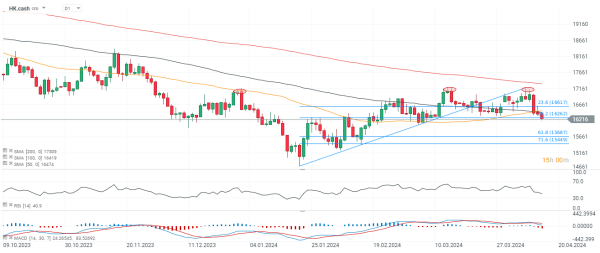HK.cash drops almost 1% after China data
The conflict in the Middle East and declines on Wall Street have somewhat diverted the markets' attention from the topic of Chinese indices, which are once again questioning the upward trend. Data from China were received negatively by investors today. The Hang Seng Index fell by over 2% in the cash session, and futures contracts are currently recording close to 1.2% declines. Although GDP readings surprised on the upside, and investments in urban areas grew faster than expected, industrial production and retail sales proved to be a significant disappointment. The market reacted negatively to the data because both indicators seem decisive in terms of consumer strength and demand for Chinese products.
- Chinese GDP growth reached 1.6% QoQ in Q1 2024 (exp. 1.4% QoQ). On an annual basis, growth accelerated from 5.2% to 5.3% YoY (exp. 4.6% YoY)
- Chinese industrial production increased 4.5% YoY in March (exp. 6.0% YoY)
- Retail sales were 3.1% YoY higher in March (exp. 4.6% YoY)
- Urban investment increased 4.5% YoY in March (exp. 4.2% YoY)
- Passenger air traffic in China increased 37.7% YoY in Q1 2024 to almost 180 million travels. This was also 10.2% higher than in pre-pandemic Q1 2019. Cargo turnover was 45.6% YoY higher at almost 34.93 billion ton-kilometers, and up 12.9% compared to Q1 2019
More regulations?
Chinese regulators intend to introduce restrictions on the visibility of trading volume on both the Hong Kong and Shenzhen stock exchanges (totaling nearly $10 trillion in market capitalization). Additionally, the exact amount of short selling will only be visible if less than 300,000 shares are sold short.
The changes are set to be implemented around 1 month after April 12 and have already been met with criticism from a number of fund managers, who suggest that this move will impact a range of existing foreign and domestic institutions in China. According to Fulbright Securities, this move aims to limit volatility and minimize the negative impact on stock market sentiment. From Monday to Tuesday morning, foreign investors reportedly sold Chinese stocks worth around 12 billion yuan (approximately $1.7 billion USD).
According to Goldman Sachs, state capital supported markets with around 200 billion yuan in Q1 2024, and foreign sentiment improved due to slightly better macro prospects, but the real estate market crisis and high debt of Chinese local governments remain fundamental risks, limiting institutional appetite for Chinese stocks.
HK.cash (D1)
The main index of companies listed on the Hong Kong Stock Exchange encountered strong resistance, marked with previous price reactions (around 17,200 points, red circles) and the 200-session simple moving average (SMA200) (red line). If bulls ultimately fail to quickly return above the 38.2 Fibonacci retracement, a test of the 61.8 retracement at 15,700 points seems likely. Should we see further declines on Wall Street, where the S&P 500 fell below the 50-day daily moving average for the first time in 50 months, sentiment in China may deteriorate further as well.

Source: xStation5